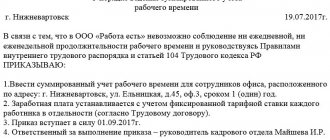Home / Labor Law / Employment / Employment contract
Back
Published: 05/09/2017
Reading time: 8 min
0
2206
The operating features of some enterprises and organizations require a special work schedule that differs from the standard forty-hour work week.
In such cases, the employer is unable to comply with legal requirements regarding the maximum permissible length of the day or week, so it becomes necessary to keep track of working time in another way.
In particular, this method is summarized accounting, the specifics of which in the employment contract should be considered in more detail.
- What does the legislation say?
- Summarized accounting: concept and application features
- Sample and rules for drawing up an employment contract
Dear readers! To solve your problem, call hotline 8 or ask a question on the website. It's free.
Ask a Question
general information
Working time (in an employment contract) is one of the most important concepts in labor relations.
The employer buys the employee's time, uses his labor power for his own purposes and ultimately gets the desired result. Scientifically based principles of organizing the work process have been developing for more than a hundred years. Taylorism is considered to be the beginning of development; it had the maximum influence on the work process at the beginning of the 19th century.
Effectively converting work time into end products is an important challenge for many disciplines. Economics, sociology, and psychology are intensively dealing with this issue.
Working hours are the time during which an employee performs his or her job duties. The legislation contains many documents regulating the regime, routine and work schedule.
According to
Article 57 of the Labor Code
The schedule of working hours and rest is mandatory to indicate. This requirement is the very first and most important requirement.
A contract without conditions of work and rest cannot be considered valid and have legal force.
Norms
According to labor legislation, the standard working time is considered to be 40 hours per week. The rule applies to all employers (legal entities, individual entrepreneurs, private and public enterprises) and to all categories of workers (with fixed-term and open-ended contracts, temporary, seasonal and others).
The standard of 40 hours is a reference point in the same way as the minimum wage level. When making calculations, it is taken as a basis; any deviations are regulated based on this standard.
We suggest you read: Re-tenancy under a lease agreement for non-residential premises
The employer does not have the right to increase working hours above the legally established ones.
But he has the right, and sometimes the obligation, to reduce the number of working hours/week.
Split working hours
This regime is regulated by Art. 105 of the Labor Code of the Russian Federation, and, as a rule, is applicable when performing work with unequal intensity throughout the entire work shift. For example, a fragmented operating mode is used by organizations providing transport services to the population, communication services and trade. The division of working time is carried out by the employer in accordance with the internal rules of the organization, drawn up taking into account the opinion of the trade union body. Russian labor legislation does not stipulate how many parts a working day can be divided into, but, as practice shows, a shift is divided into 2 or more parts, and the unpaid break between them can be no more than 2 hours.
Modes
Working hours (in an employment contract) are a way of organizing an employee’s time and workforce. There are several types of such organizations in the legislation. The concept of a work schedule (or work schedule in an employment contract) intersects with the concept of a work schedule.
In some cases they mean the same thing. The 16th chapter of the Labor Code (Articles 100-105 of the Labor Code) is responsible for the main provisions of the working time regime.
Regular (single shift) - the simplest case is a five- and six-day work week.
The employee comes to work every day.
He definitely has one or two days off.
There is actually no shift - since there is only one.
An employee cannot work more than 40 hours a week.
All hours (in excess of normal) are counted as overtime and paid accordingly. The method is applicable for a wide range of works - office, retail, research, and some industrial production.
Irregular working hours in an employment contract are a more complex case. The regulating article is Article 101 of the Labor Code. An employee is sometimes involved in the performance of his work function on orders from superiors or necessity.
Engagement extends beyond the normal working hours. An employee can be called before the start of the working day or remain after it ends. The list of groups of workers with such a regime is indicated, for example, in a collective agreement.
Often practiced among administrators, managers and technicians. personnel. Employees employed under this scheme are entitled to additional rest, and overtime is considered overtime.
Shift working hours
It is a form of performance of labor activity by an employee without the possibility of daily return to his place of residence. This regime is usually used by employers during the construction or reconstruction of facilities in order to reduce the time frame for project implementation. Shift work involves providing employees with conditions for normal living, most often these are special mobile buildings and structures created by the employer, equipped with everything necessary. The duration of the shift is determined by labor legislation and is no more than 1 month (if the shift period is increased to 3 months, Article 299 of the Labor Code of the Russian Federation, the employee is paid additionally). The duration of a work shift during a shift should be no more than 12 hours. For the calculation, the summarized accounting of working hours for a month, quarter or 1 year is used. This accounting period includes total working time, time spent traveling to the collection point, place of work and back, rest time, which coincides with the calendar period. The shift work schedule is communicated to employees no later than 2 months in advance. This regime provides for a number of restrictions (Article 298 of the Labor Code of the Russian Federation), according to which the following cannot be hired to work on a rotational basis:
- workers under 18 years of age;
- pregnant women;
- women who are dependent on young children under 3 years of age;
- employees who have medical contraindications.
Accounting
Article 91 of the Labor Code obliges the employer to keep records of working hours. This is the direct responsibility of the employer; he is responsible for organizing the accounting.
We invite you to read: Part-time work without dismissal
But the right to choose which accounting method is most convenient for the enterprise remains with the employer.
For large enterprises, accounting is usually carried out using a special time sheet. Small organizations often prepare a statement.
There are several types of accounting:
- Daily.
- Weekly.
- Summarized.
Day accounting is best used if the employee’s working hours are constant.
For example, he works 6 hours every day.
Overworking of a given norm on one day cannot be compensated by shortcomings on another day.
Because, in fact, this can become a flexible schedule, requiring a different way of accounting.
Weekly - used if the number of working hours/week is determined. The method is a little “wider” in use. An employee can work a different number of working hours per day, the main thing is the established norm per week.
For example, the standard is 30 hours and a five-day week. In this accounting system, an employee can work 2 days for 3 hours each, and the remaining 3 days for 8 hours each. The norm cannot exceed 40 hours.
Summarized accounting of working time in an employment contract is the best solution for those types of work where, due to the conditions of the work process, it is impossible to comply with/determine daily or weekly time standards.
To put it another way, measuring the exact number of hours per week is too difficult because the production cycle is very long. It lasts for many weeks or even months.
In this case, it is recommended to use summarized accounting. The main article in the summary recording of working time is Article 104 of the Labor Code.
Now a few words about how to apply summarized accounting and implement it in an enterprise. First, determine the reporting period - it can be a week, month, quarter, year.
A period of more than a year cannot be set. For enterprises with hazardous conditions it is less - 3 months. A one-day period is also prohibited, since in fact this will already be a daily accounting.
We suggest you read: Objection to the plaintiff’s complaint
Attention! Individual employers are prohibited from using summary accounting.
After determining the period, the standard hours for the selected period of time are established.
For example, per quarter you are entitled to 120 slaves. hours.
Then an order is issued and included in the collective agreement or wage regulations.
Accordingly, new employees are familiarized with the payment method in the form of an annex to the employment contract.
Compensation for overtime and shortcomings is permitted only within a specified period.
If overtime was recorded during the period, then they are paid as overtime according to the general rules.
Flexible working hours
This regime is a form of labor organization with self-regulation of the duration, beginning and end of the working day. However, even with a flexible work schedule, it is necessary to work out the number of working hours established by labor legislation for a certain period - day, week, month (Article 102 of the Labor Code of the Russian Federation). The flexible working time regime provides for a sliding work schedule, which is established by mutual agreement between the employee and the employer upon hiring or throughout the entire working life. This regime can be established for either a definite or an indefinite period, and is documented in an administrative document of the employer. Flexible working hours are most often used in cases where the use of regular schedules is ineffective or impossible. It is inappropriate to use flexible working hours in cases of continuous production, three-shift work schedules, as well as in types of production with special safety regulations. The use of a flexible work schedule does not affect wages, the calculation of seniority, or the provision of benefits. This mode of work is not entered into the employee’s work book. The main components of a flexible working mode are considered to be:
- Flexible time is the beginning and end of a work shift, when an employee has the right to start and finish work at a time convenient for him.
- Fixed time is a period of a work shift when an employee is required to be at the workplace.
The duration of the main components of a flexible working time regime is determined by the internal labor regulations of the organization. An accounting period can be considered a week, a month, a quarter, and other mode options that are more convenient for the employee and the organization.
Employees performing their work duties on a flexible schedule may be required to perform overtime work in the manner provided for in Art. 99 Labor Code of the Russian Federation.
Shift working hours, as a rule, are introduced in production in order to increase the efficiency of equipment use and increase the volume of products produced, while the working period of the production process is significantly higher than the permissible duration of the daily work schedule. The shift schedule distributes the working hours of workers who are involved in the production process, or for certain categories of workers. The work shift schedule determines the number of shifts, the start and end times of the shift, the order of rotation, and sets breaks for meals and rest. The shift work schedule must be approved by the employer, taking into account the opinion of the representative body of employees (for example, a trade union committee), which must be notified of this no later than 1 month before the start of work according to this schedule. Changing the shift work schedule is not possible. Based on Art. 110 of the Labor Code of the Russian Federation, all shift schedules are drawn up taking into account the provision of weekly uninterrupted rest to workers, the duration of which must be at least 42 hours. Rest between shifts must be no less than double the working time preceding the rest in the shift. Engaging an employee to perform labor duties for two shifts in a row is not permitted.
Decor
To specify the operating mode and method of accounting, approximately the following is added to the contract:
- The employee is assigned a summarized accounting method. The accounting period is one month.
- The employee works in flexible working hours.
The following points are described in detail. For a flexible schedule, a standard, fixed work time, and rest schedule are established.
Since the points relating to working hours and accounting methods are mandatory conditions (according to Article 57 of the Labor Code), their indication is always necessary.
Setting up a flexible work schedule
The main question for an employer is how to properly draw up an employment contract with a flexible schedule? The specifics and conditions for this agreement are contained in the labor laws of the Russian Federation. If the employment contract is drawn up incorrectly, the organization faces a fine and suspension of activities.
A package of documents when registering a GDV is formed depending on the status of the employee - hiring for a position or already an employee of the company.
In the first option, the terms of GDV are included in the text of the working agreement and detail the working time. The order to hire an employee must be executed in form T-1 and contain the conditions for starting work on the GDV.
In the second option, the employee must write a statement with a request and consent to install GDV. After this, an additional agreement is formed indicating a specific time and an order is issued in free form, which indicates the period for the commencement of the GDV and the agreed period of work.
Employment contract with flexible working hours - sample
The execution of this document contains a change in the conditions and nature of the performance of duties. In this section you need to indicate the GDV and add features for this schedule. Otherwise, the specifics of drawing up a contract are similar to the general regime.









